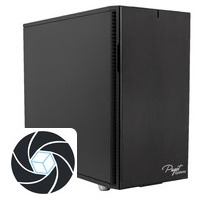Table of Contents
Introduction
Here at Puget Systems, specifically in the Labs department, most of the content that we write falls into one of two categories: either long, fairly in-depth articles looking at the performance of various PC components in a given application or recommended system pages, with multiple configuration options aimed at different budgets and lots of supporting data drawn from the aforementioned articles. For some readers, all of that is information overload, though, and they just want a quick question answered: what is the best computer for my needs? We’ve started answering that question more directly in a series of short articles, like this one, which we hope to update regularly.
Today we are looking at RealityCapture, a photogrammetry application for reconstructing virtual versions of real-life objects and places from sequences of digital photos. It uses the CPU for most of the heavy lifting but also benefits from CUDA-compatible graphics cards, which are required for some processing steps, and large image sets need a lot of drive capacity (and speed) as well.
Good PC Configuration for RealityCapture
We'll start off with a good, solid workstation design for RealityCapture – without too high of a price tag. This application performs best with a CPU that has a combination of high clock speed and fairly high core count, which means that AMD's latest generation of Ryzen processors do very well here. The Ryzen 7 5800X is a solid starting choice – and 32GB of memory will usually be sufficient for aligning projects with even thousands of images at standard settings. RealityCapture also requires a NVIDIA graphics card for certain steps, so we'll start with a single GeForce RTX 3070 there, and a couple of fast SSDs for the boot and storage drives.
| CPU | AMD Ryzen 7 5800X 8-core |
| Video Cards | NVIDIA GeForce RTX 3070 8GB |
| RAM | 32GB DDR4 |
| Drives | 500GB & 1TB NVMe SSDs |
Configure System With These Specs
Better PC Configuration for RealityCapture
Stepping up from there, we can move to the Ryzen 9 5900X with a few more cores and double up on the number of GeForce RTX 3070 video cards. That combination should increase RealityCapture performance by 10-20% over the previous design. System memory is doubled for aligning even bigger image sets, and we bump up the total SSD capacity for the same reason.
| CPU | AMD Ryzen 9 5900X 12-core |
| Video Cards | 2x NVIDIA GeForce RTX 3070 8GB |
| RAM | 64GB DDR4 |
| Drives | 1TB & 2TB NVMe SSDs |
Configure System With These Specs
Best PC Configuration for RealityCapture
For the best performance in RealityCapture, we step up to the top-end Ryzen 9 5950X. We'll also bump the video cards up to GeForce RTX 3080 models, still in a pair. This only nets about a 5% increase in performance over the "better" configuration, though, so it won't be worthwhile for everyone. RAM is doubled again, to the maximum the Ryzen platform supports, but this much memory will only be needed for extremely large image set alignment at high quality settings. Drive capacity is once again increased – but please remember that you can adjust storage as needed for your specific workload. Lastly, a longer warranty will help protect this big investment.
| CPU | AMD Ryzen 9 5950X 16-core |
| Video Cards | 2x NVIDIA GeForce RTX 3080 10GB |
| RAM | 128GB DDR4 |
| Drives | 2x 2TB NVMe SSDs |
Configure System With These Specs
Many of the options on the configurations above can be adjusted as you see fit, to best line up with your specific needs and budget.
If you are working on aligning extremely large image sets, at the highest quality settings, the 128GB memory maximum on AMD's Ryzen processors could theoretically become a limiting factor. In such cases, moving up to AMD's Threadripper 3rd Gen will double that to 256GB maximum – but at the cost of reduced performance compared to the top-end Ryzen models used above, and at a higher price tag.
Additional Resources
If you want to know more about RealityCapture performance, we have published several articles over the years looking at how various CPUs and video cards compare when processing different image sets. We also have public benchmarks that you can download and run on your own system to see how it stacks up with the latest hardware. And if you aren’t sure what you need, or if your workflow includes multiple applications, please feel free to call or email our consultants to get a more personalized configuration.
Puget Systems offers a range of powerful and reliable systems that are tailor-made for your unique workflow.

